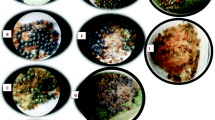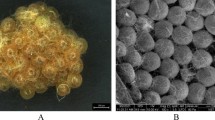Abstract
Bioassays were carried out in Petri dishes with body washings of larvae, male and female moths and scale extract of Corcyra cephalonica St. in hexane to observe their kairomonal effect on Trichogramma brasiliensis (Ashmead) and T. japonicum Ashmead. The mean parasitoid activity index (PAI) and mean parasitisation were recorded. Trichogramma brasiliensis and T. japonicum recorded the highest mean parasitisation in the eggs treated with scale extract. Mean parasitisation recorded by T. japonicum in cards treated with female moth and male moth body washings were considerably lower than the corresponding values for T. brasiliensis. Both the parasitoids recorded significantly lower levels of parasitisation in cards treated with larval body washings. Gas chromatographs of host body washings / extract recorded a large number of similar hydrocarbons in the body washings of male and female moths and the scale extract. Pentadecane, heneicosane, eicosane, tetracosane, pentacosane and hexacosane were recorded in scale extracts. Female moth body washings recorded the presence of eicosane, tetracosane and pentacosane while heneicosane and eicosane were indicated in the male moth body washings.
Résumé
Des essais biologiques de laboratoire ont été menés par rinçages à l’hexane du corps des larves, des adultes mâles et femelles, ainsi que par l’extrait d’écailles de Corcyra cephalonica St., afin d’observer leurs effets kéromonaux sur Trichogramma brasiliensis (Ashmead) et T. japonicum Ashmead. L’index d’activité moyenne du parasitoïde (IAP) ainsi que la moyenne de parasitisme étaient notés. La moyenne la plus élevée de parasitisme a été observée chez T. brasiliensis et T. japonicum sur les oeufs traités aux extraits d’écailles. La moyenne de parasitisme observée chez T. japonicum sur les cartes traitées au moyen des rinçures du corps des adultes mâles et femelles était considérablement très basse en comparaison des valeurs correspondantes enregistrées pour T. brasiliensis. Pour tous les deux parasitoïdes, les niveaux de parasitisme étaient bas dans le cas des cartes traitées au moyen des rinçures corporelles obtenues des larves. Les chromatographies à phase gazeuse des rinçures corporelles / extrait de l’hôte ont révélé la présence d’une large gamme d’hydrocarbonates similaires dans les rinçures des adultes mâles et femelles, de même que dans l’extrait d’écaillés. La pentadécane, l’hénéicosane, l’éicosane et l’hexacosane étaient obtenues dans les extraits d’écaillés. Les rinçures du corps de la femelle ont témoigné de la présence de l’éicosane, la tétracosane et de la pentacosane randis les rinçures du mâle ont révélé la présence de l’hénéicosane et de l’éicosane.
Similar content being viewed by others
References
Ananthakrishnan T. N. (1992) Chemical ecology in biological control, pp. 59–68. In Emerging Trends in Biological Control of Phytophagus Insects (Edited by T. N. Ananthakrishnan). Oxford and IBH Publishing Co.
Ananthakrishnan T. N., Senrayan R., Murugesan S. and Annadurai R. S. (1991) Kairomones of Heliothis armigera and Corcyra cephalonica and their influence on the parasitic potential of Trichogramma chilonis (Trichogrammatidae: Hymenoptera). J. tBiosc. 16, 111–119.
Kovat E. (1965) Gas chromatographic characterisation of organic substances in the retention index system. Adv. Chromat. 1, 229–247.
Lewis W. J., Jones R. L, Nordlund D. A. and Sparks A. N. (1975a) Kairomones and their use for management of entomophagous insects: I Evaluation for increasing rates of parasitisation of Trichogramma spp. in the field. J. Chem. Ecol. 1, 343–347.
Lewis W. J., Jones R. L, Nordlund D. A. and Gross Jr. H. R. (1975b) Kairomones and their use for management of entomophagous insects: II Mechanisms causing increase in rate of parasitisation by Trichogramma spp. J. tChem. Ecol. 1, 349–360.
Lewis W. J., Jones R. L. and Sparks A. N. (1972) A host seeking stimulant for the egg parasite Trichogramma evanescens: Its source and a demonstration of its laboratory and field activity. Ann. Entomol. Soc. Am. 65, 1087–1089.
Morrisson G. and Lewis W. J. (1981) The allocation of searching time by Trichogramma pretiosum in host-containing patches. Entomol. Exp. Appl. 30, 31–39.
Paul A. V. N. (1973) Studies on the egg parasite Trichogramma australicum Girault and T. japonicum Ashmead (Trichogrammatidae: Hymenoptera) with special reference to host parasite relationship. MSc (Agric.) Thesis, TNAU, Tamil Nadu, India.
Thomson M. S. and Stinner R. E. (1990) The scale response of Trichogramma (Hymenoptera: Trichogrammatidae): Variation among species in host specificity and the effect of conditioning. Entomophaga 35, 7–21.
Author information
Authors and Affiliations
Additional information
See Editor’s Note at the end of this issue.
Rights and permissions
About this article
Cite this article
Paul, A.V.N., Madhu, S. & Singh, D.B. Kairomonal Effects of Different Host Body Washings on Parasitism by Trichogramma Brasiliensis and T. Japonicum. Int J Trop Insect Sci 17, 373–377 (1997). https://doi.org/10.1017/S1742758400019214
Accepted:
Published:
Issue Date:
DOI: https://doi.org/10.1017/S1742758400019214




